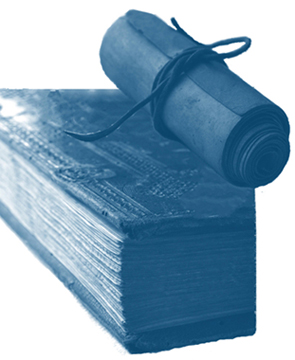 It is impossible to establish exactly when the book was invented or first began to circulate. Indeed, none of the forms exhibited here can be considered the embryo of what we have come to refer to as books. Nevertheless, if we narrow our scope to the Laurentian manuscript collection—in itself quite extensive—it would appear that the potsherd on which, probably under dictation, a pupil from the 2nd century BC wrote the ancient verses of one of Sappho’s odes marks the most significant threshold of its history; the fragment represents the longest extant portion of the poem, which may have been dedicated to Aphrodite. The ostracon is a rare medium due solely to the fact that, since it is a fragile material that was not used for anything meant to endure, large quantities have not been handed down to us. The book form we chose as our endpoint—and thus closer to our own era—is a 19th-century Japanese erotic-grotesque scroll expressing a genre that enjoyed widespread and lasting circulation because of its caricatural and entertaining contents. Due to its distant provenance, however, it is a rarity in Italian libraries. Between these two intentionally striking extremes, we have created an itinerary that requires some explanation.
It is impossible to establish exactly when the book was invented or first began to circulate. Indeed, none of the forms exhibited here can be considered the embryo of what we have come to refer to as books. Nevertheless, if we narrow our scope to the Laurentian manuscript collection—in itself quite extensive—it would appear that the potsherd on which, probably under dictation, a pupil from the 2nd century BC wrote the ancient verses of one of Sappho’s odes marks the most significant threshold of its history; the fragment represents the longest extant portion of the poem, which may have been dedicated to Aphrodite. The ostracon is a rare medium due solely to the fact that, since it is a fragile material that was not used for anything meant to endure, large quantities have not been handed down to us. The book form we chose as our endpoint—and thus closer to our own era—is a 19th-century Japanese erotic-grotesque scroll expressing a genre that enjoyed widespread and lasting circulation because of its caricatural and entertaining contents. Due to its distant provenance, however, it is a rarity in Italian libraries. Between these two intentionally striking extremes, we have created an itinerary that requires some explanation. Tuesday 15 September 2009
The shape of the book
 It is impossible to establish exactly when the book was invented or first began to circulate. Indeed, none of the forms exhibited here can be considered the embryo of what we have come to refer to as books. Nevertheless, if we narrow our scope to the Laurentian manuscript collection—in itself quite extensive—it would appear that the potsherd on which, probably under dictation, a pupil from the 2nd century BC wrote the ancient verses of one of Sappho’s odes marks the most significant threshold of its history; the fragment represents the longest extant portion of the poem, which may have been dedicated to Aphrodite. The ostracon is a rare medium due solely to the fact that, since it is a fragile material that was not used for anything meant to endure, large quantities have not been handed down to us. The book form we chose as our endpoint—and thus closer to our own era—is a 19th-century Japanese erotic-grotesque scroll expressing a genre that enjoyed widespread and lasting circulation because of its caricatural and entertaining contents. Due to its distant provenance, however, it is a rarity in Italian libraries. Between these two intentionally striking extremes, we have created an itinerary that requires some explanation.
It is impossible to establish exactly when the book was invented or first began to circulate. Indeed, none of the forms exhibited here can be considered the embryo of what we have come to refer to as books. Nevertheless, if we narrow our scope to the Laurentian manuscript collection—in itself quite extensive—it would appear that the potsherd on which, probably under dictation, a pupil from the 2nd century BC wrote the ancient verses of one of Sappho’s odes marks the most significant threshold of its history; the fragment represents the longest extant portion of the poem, which may have been dedicated to Aphrodite. The ostracon is a rare medium due solely to the fact that, since it is a fragile material that was not used for anything meant to endure, large quantities have not been handed down to us. The book form we chose as our endpoint—and thus closer to our own era—is a 19th-century Japanese erotic-grotesque scroll expressing a genre that enjoyed widespread and lasting circulation because of its caricatural and entertaining contents. Due to its distant provenance, however, it is a rarity in Italian libraries. Between these two intentionally striking extremes, we have created an itinerary that requires some explanation.
Subscribe to:
Posts (Atom)
Contents of the day
Article of the Day
Article of the Day
provided by The Free Dictionary
This Day in History
This Day in History
provided by The Free Dictionary
Today's Birthday
Today's Birthday
provided by The Free Dictionary
In the News
In the News
provided by The Free Dictionary
Quote of the Day
|
To have a right to do a thing is not at all the same as to be right in doing it.
Gilbert Chesterton (1874-1936) |
Quote of the Day
provided by The Free Library